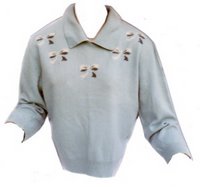 Contributed By: FuzzyLizzie
Contributed By: FuzzyLizzieOriginally Published: VFG Cashmere History
Until the 1920s, knitted sweaters were utilitarian or athletic items, not fashion statements. This all changed with Patou and Chanel in the 20s, and with Schiaparelli in the 30s. By 1933, Pringle in Scotland was making fashionable sweaters of cashmere, and introduced the twin set shortly thereafter.
It took Hollywood to make the sweater a star. In 1937 Lana Turner appeared in They Won’t Forget wearing a tight sweater. The Sweater Girl was born!
In 1940, American designer Claire Potter included decorated evening sweaters in her collection. A year later, Mainbocher took British-made cashmere cardigans and decorated them for evening wear. Sometimes they were made as part of a dress ensemble, with the lining of the sweater matching the dress. They were decorated with beads, sequins, metal studs and fabric trim. This started a trend for decorated sweaters that continued into the 1960s
The evening sweater was an important part of the 1950s wardrobe. These sweaters were decorated in various ways: sequins, embroidery, appliqué, lace, beads, rhinestones and huge fur collars. A sweater would often exhibit a combination of these decorations. Many were lined in sheer, light-weight silk, sometimes with a layer of lace between the sweater and the silk.
Cashmere also became very popular for day. Many women had a twin set or two. A twin set was a pullover, often sleeveless or with short sleeves, and a matching cardigan. Sometimes the two pieces contrasted with coordinating trim. The sweaters often had jewel necklines to complement the string of pearls that many women wore with them.
From the 1940s and into the 1950s, teenage girls would wear their (or their mothers’) cardigans backward, buttoned up the back. College girls of the period bought twin sets as an important part of their college wardrobes.
Cashmere sweaters were knit not only in lovely solid colors, they were also knit in intarsia designs. Argyles were popular, as were flowers, butterflies and other designs from mature. There were often pretty details such as collars, matching mother-of-pearl buttons and contrasting satin trim.
Most 1950s sweaters had three-quarter, or bracelet, length sleeves. This sleeve length remained popular into the early 60s. Later in the decade, sleeves lengthened to cover the wrist.
Read on about what to look for in vintage cashmere sweaters here.
And to answer the trivia question from our last post...
Who coined the term "Fashion Victim"?
The phrase "Fashion victim" was coined by Oscar de la Renta, according to John Fairchild: "We were sitting at the Caravelle and Oscar looked around and said, 'These people are absolute hell, they look like fashion victims,' and that was the first time anyone had used that expression." - From the book The Fashion Conspiracy written in 1988 by Nicholas Coleridge.
